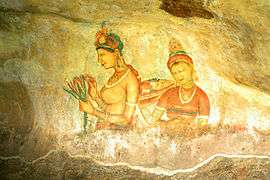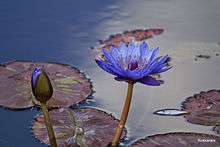Nymphaea nouchali
| Nymphaea nouchali | |
|---|---|
| | |
| Scientific classification | |
| Kingdom: | Plantae |
| (unranked): | Angiosperms |
| Order: | Nymphaeales |
| Family: | Nymphaeaceae |
| Genus: | Nymphaea |
| Species: | N. nouchali |
| Binomial name | |
| Nymphaea nouchali Burm. f. | |
| Synonyms[1] | |
| |
Nymphaea nouchali, often known by its synonym Nymphaea stellata, or by common names blue lotus,[1] star lotus, red and blue water lily, or blue star water lily is a water lily of genus Nymphaea. It is native to southern and eastern parts of Asia, and is the national flower of Sri Lanka and Bangladesh. This species is sometimes considered to include the blue Egyptian lotus Nymphaea caerulea.[2] In the past, taxonomic confusion has occurred, with the name Nymphaea nouchali incorrectly applied to Nymphaea pubescens.[3]
Distribution and habitat
_in_Hyderabad%2C_AP_W_IMG_2624.jpg)
This aquatic plant is native in a broad region from Afghanistan, the Indian subcontinent, to Taiwan, southeast Asia, and Australia.[1] It has been long valued as a garden flower in Thailand and Myanmar to decorate ponds and gardens. In its natural state, N. nouchali is found in static or slow-flowing aquatic habitats of low to moderate depth.
Description
N. nouchali is a day-blooming nonviviparous plant with submerged roots and stems. Part of the leaves are submerged, while others rise slightly above the surface. The leaves are round and green on top; they usually have a darker underside. The floating leaves have undulating edges that give them a crenellated appearance. Their size is about 20–23 cm and their spread is 0.9 to 1.8 m.
This water lily has a beautiful flower which is usually violet blue in color with reddish edges. Some varieties have white, purple, mauve, or fuchsia-colored flowers, hence its name red and blue water lily. The flower has four or five sepals and 13-15 petals that have an angular appearance, making the flower look star-shaped from above. The cup-like calyx has a diameter of 11–14 cm.
Symbolism

It was also the National flower of the former defunct Hyderabad State.
N. nouchali is the national flower of Bangladesh.[4] A pale blue-flowered N. nouchali is the national flower of Sri Lanka, where it is known as nil mānel or nil mahanel (නිල් මානෙල්).[5]
In Sri Lanka, this plant usually grows in buffalo ponds and natural wetlands. Its beautiful aquatic flower has been mentioned in Sanskrit, Pali, and Sinhala literary works since ancient times under the names kuvalaya, indhīwara, niluppala, nilothpala, and nilupul as a symbol of virtue, discipline, and purity. Buddhist lore in Sri Lanka claims that this flower was one of the 108 auspicious signs found on Prince Siddhartha's footprint.[6] It is said that when Buddha died, lotus flowers blossomed everywhere he had walked in his lifetime.
N. nouchali might have been one of the plants eaten by the Lotophagi of Homer's Odyssey.
Uses
N. nouchali is used as an ornamental plant because of its spectacular flowers, and is most commonly used for the traditional and cultural festivals in Sri Lanka. It is also popular as an aquarium plant under the name "dwarf lily" or "dwarf red lily". Sometimes, it is grown for its flowers, while other aquarists prefer to trim the lily pads, and just have the underwater foliage.
N. nouchali is considered a medicinal plant in Indian Ayurvedic medicine under the name ambal; it was mainly used to treat indigestion.[7]
Like all water lilies or lotuses, its tubers and rhizomes can be used as food items; they are eaten usually boiled or roasted. In the case of N. nouchali, its tender leaves and flower peduncles are also valued as food.[8]
The dried plant is collected from ponds, tanks, and marshes during the dry season and used in India as animal forage.[9]

See also
- Nymphaea caerulea, the Egyptian blue lotus or sacred lotus
- Nymphaea lotus, the white lotus or Egyptian white water lily
- List of freshwater aquarium plant species
References
- 1 2 3 USDA GRIN Taxonomy, retrieved April 20, 2015
- ↑ The Plant List: A Working List of All Plant Species, retrieved 20 April 2015
- ↑ Dezhi Fu; John H. Wiersema & Donald Padgett, Flora of China online, 6, retrieved 20 April 2015
- ↑ Constitution Of The People's Republic Of Bangladesh
- ↑ Hettiarachchi, Kumudini (November 7, 2010). "The Great Pretender". The Sunday Times, Sri Lanka. Retrieved 24 June 2013.
- ↑ TokyoNet - National Statistics
- ↑ P. V. Sharma, Puṣpāyurvedaḥ - Pradhāna vitaraka Caukhambhā Bhāratī Akādamī, 1998
- ↑ FR Irvine, RS Trickett - Water lilies as Food - Kew Bulletin, 1953
- ↑ A Banerjee, S Matai - Composition of Indian aquatic plants in relation to utilization as animal forage - Journal of Aquatic plant management, 1990
External links
- Neel kamal (blue waterlily) in Indian culture on Biodiversity of India portal.
- Taxon: Nymphaea stellata Willd. - Synonym of Nymphaea nouchali Burm. f.
- Perry D. Slocum: Waterlilies and Lotuses. Timber Press 2005, ISBN 0-88192-684-1 (restricted online version at Google Books)
- Ambal (Nymphaea stellata) - Flowers of India - Kerala Ayurvedics
| Wikimedia Commons has media related to Nymphaea nouchali. |